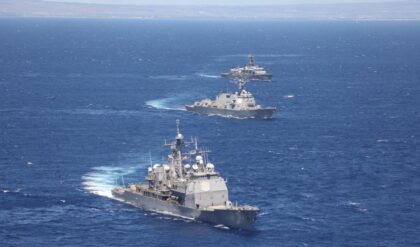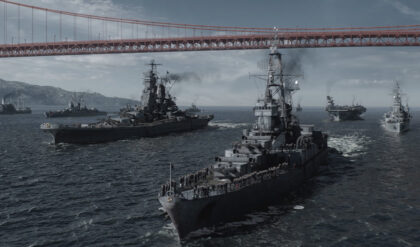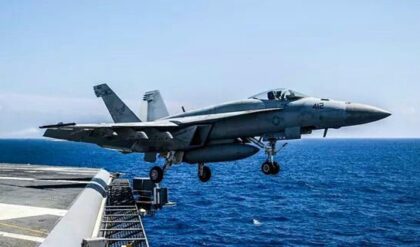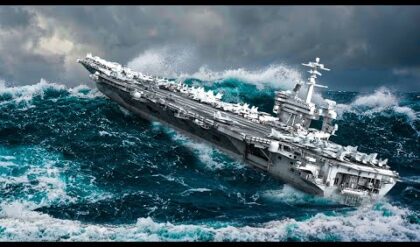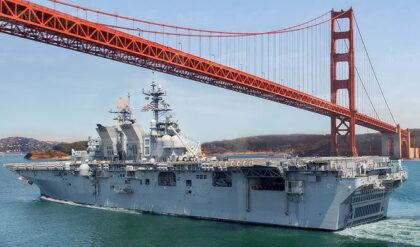In the 1950s the Soviets were looking for a truck that was as good as a normal vehicle on road, and as good as a tank off road. This tall order was answered with the ZiS-E134, a beast of a truck that could quite literally go anywhere.

It was an 8×8 with four-wheel steering, adjustable tire pressures and incredible traction. It proved its worth even against the Russian rasputitsa, and an amphibious version covered water-based activities.
However these fantastic trucks didn’t enter service due to a late change in requirements.
Background
After the Second World War the Soviet Union understood that there were limitations with the trucks used in their logistical system. This problem was made even worse in the early years of the Cold War due to the development of guided missiles and much more accurate bombing.
These weapons would likely be used used against roads and transport networks at the start of a conflict with the west, knocking out their supply system early on. If operations were to continue in these circumstances, the Soviets would have to use off-road supply routes instead.
Interestingly, the US tried solving this same issue in the 1940s with their massive T-23 truck.
 The ZIS-151 was typical of Soviet post-WWII trucks.
The ZIS-151 was typical of Soviet post-WWII trucks.
But the situation was worse for the USSR because of the sheer size of their territory and the brutal ground conditions within it. Their stock of trucks at the time were simply unable to easily switch back and forth between roads and cross country.
Tracked vehicles were much better off road and could handle most of the terrain that would be encountered. However tracked vehicles are inherently more complex, so they were much more expensive to build and run and much less reliable. But, perhaps most importantly, trucks were far more efficient when on roads.
So in 1954 the Council of Ministers of the USSR initiated a project to develop a wheeled vehicle that could be as good off-road as a tracked machine, and as good on road as a truck.
Development of the ZiS-E134
A small team was created to develop this truck, headed by Vitaly Andreevich Grachev. Grachev was a famed designer that had already won the State Prize twice.
They quickly drew up designs for a four axle, eight wheel, eight wheel drive truck that had a cargo capacity of 5-6 tons.
The team had to incorporate many unusual, non-standard features into the truck just so it could operate in the USSR’s harsh environments. These included a central tire pressure system, a torque converter, four wheel steering, and highly elastic tires.
 A top-down view of ZIS-E134 plans.
A top-down view of ZIS-E134 plans.
They named their truck the ZiS-E134 Model No.1.
In only around a year, the final specifications were complete and the team were ready for a prototype. This was completed in August 1955. Testing began almost immediately.
ZiS-E134 Model No.1
The ZiS-E134 was a large truck, with four axles and eight wheels for maximum traction. It measured 6.6 meters in length and weighed 7.7 tons empty. On top, the bodywork and bed was taken from the ZIS-151-type truck.
The axles were the same as the BTR-152 for parts commonality, and each connected to huge, 1.2 meter-wide tires. These tires were specially designed for high elasticity so they could absorb shock, reducing the wear on suspension components.
But this elasticity also complemented the truck’s central tire pressure system, which could individually reduce or increase the pressure in each of the eight tires. This is a common trick for off-roaders, as lower pressure tires squish down and have a larger contact area with the ground.
 The ZIS-E134. The body was taken from a ZIS-151 truck.
The ZIS-E134. The body was taken from a ZIS-151 truck.
However at the time, on-board tire pressure adjustments was not common. Thanks to the ZiS-E134’s very elastic tires, the pressure inside could be reduced to as low as 3 psi and kept there for long periods of time. At this pressure, the tires’ contact area was five times greater than standard.
A 5.5 litre, 6 cylinder 130 hp engine was mounted at the front of the truck, and drove the wheels through a 5-speed transmission.
Interestingly, the engine and transmission were connected via a torque converter instead of a normal clutch. This reduced the shock on the drivetrain and made the driving experience much smoother.
 Each wheel was spaced 1.5 meters apart. Note the tire pressure lines outside of each wheel.
Each wheel was spaced 1.5 meters apart. Note the tire pressure lines outside of each wheel.
A transfer case offered low-range gearing for increased torque at low speeds. From here, power was sent via prop shafts to the four axles. The ZiS-E134 could run in four wheel drive, or eight wheel drive.
For additional off-road performance, the differentials were self-locking. This stopped the wheels on each axle spinning at different rates to each other in soft ground. And, for the benefit of wear and the driver, the ZiS-E134 rode on springs and hydraulic shock absorbers.
Steering was achieved through the ZiS-E134’s four front wheels.
 The ZIS-E134’s designed provided fantastic off-roading.
The ZIS-E134’s designed provided fantastic off-roading.
ZiS-E134 Model No.2
The success of the ZiS-E134 Model No.1 led to a second version, Model No.2.
This machine used many of the same components as Model No.1, but it was amphibious. It was first hoped that the movement of the tires would be enough to propel the truck through water, but when this didn’t work, it was fitted with a water jet from the PT-76 amphibious tank.
Top speed in water was around 4 mph.
 ZIS-E134 Model 2. This version had an open crew compartment.
ZIS-E134 Model 2. This version had an open crew compartment.
As the tires for these trucks were so springy, designers actually ended up fitting the Model No.2’s wheels rigidly to the chassis, without any form of suspension. It simply relied on its soft tires for shock absorption.
Like Model No.1, Model No.2 also had four axles and stored its cargo in a bed at the rear.
However instead of a truck-like cab, Model No.2 had an open crew compartment that could be optionally covered by canvas, supported by ribs.
 ZIS-E134 Model 2 with its canvas removed.
ZIS-E134 Model 2 with its canvas removed.
Testing
Testing began in October 1955, almost immediately after the prototype was completed.
The ZiS-E134 quickly proved to be an absolute off-road king. It was driven late in the year, during the infamous mud season known as rasputitsa. Long distances were travelled in extremely difficult conditions, where things like diff locks, reduced tire pressures and all wheel drive were necessary to make progress.
Its huge 370 mm ground clearance was fantastic over rough ground, and it was even capable of climbing a 60 cm vertical wall. It could ford 1 meter of water, drive through waist height swamps, and cross 1.5 meter-wide trenches.
 The Model 1 was capable of crossing 1.5 meter-wide trenches.
The Model 1 was capable of crossing 1.5 meter-wide trenches.
Incredibly, it was capable of doing all this with 3 tons of cargo in the back and a relatively comfortable driver. The automatic transmission and power steering made his time in the two-man cab much easier than in standard cargo trucks of the day.
The adjustable tire pressure system fed air into the tires via hoses that extended outside the wheels. Reportedly this system worked fine, but one questions how long this would survive while moving through forests, past rocks etc.
During the tests it was often observed that the suspension was barely involved, as the extremely soft tires were absorbing most of the shock. This would later lead to a few vehicles that had no suspension at all, instead relying entirely on the cushioning from the tires.

The Model 2 had rigid suspension. The tires did all of the work.
In some conditions, the ZiS-E134 actually showed better performance than tracked vehicles as it had a lower ground pressure. In early 1956, it was tested in very deep snow against the best off-roaders the USSR had to offer.
Due to its ground clearance snow had a tendency to build up around chassis, but it proved capable of moving through up to 650 mm of snow. When a plough was fitted to the front, the ZiS-E134 travelled through 1.2 meter tall snow banks.
Overall it showed itself to be one of the best of the bunch, beating out other wheeled vehicles and even many tracked ones.
 The ZiS-E134 trucks were even happy in deep snow.
The ZiS-E134 trucks were even happy in deep snow.
Cancellation
Despite the capabilities of the ZiS-E134 trucks, they wouldn’t ultimately enter service. This is strange considering they were some of the most capable off-roaders in the world at the time, but this was not the reason for their cancellation.
It was a simple change of requirements that would be their end.
 Despite the capabilities of the trucks, they were ultimately cancelled.
Despite the capabilities of the trucks, they were ultimately cancelled.
The original requirements stated a cargo capacity of 3 tons, and a towed weight of 6 tons – both of which the ZiS-E134 successfully met. But during the project the military decided that they wanted double the cargo capacity and double the towed weight.
This was not something that could be achieved by simply modifying the truck, so in the end the vehicle was cancelled. Not all was lost though, as the lessons learned during the project were applied to later vehicles.
